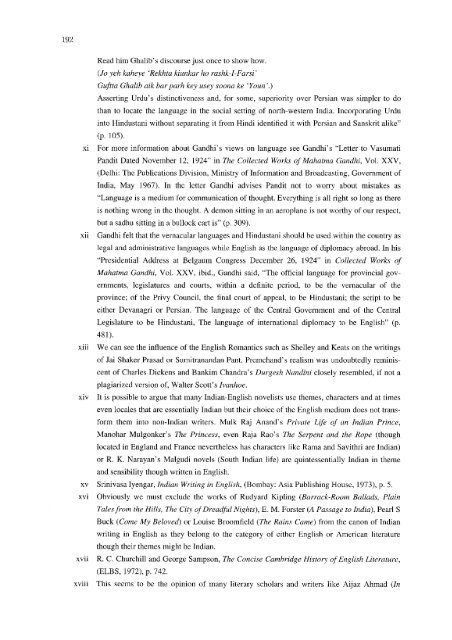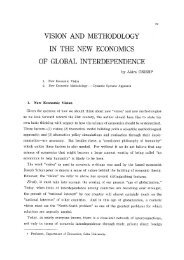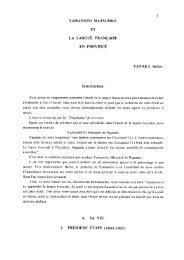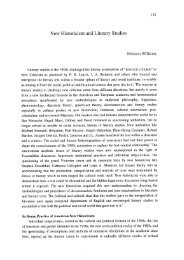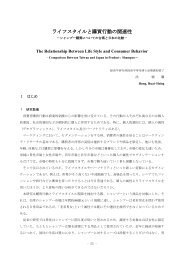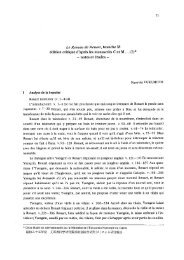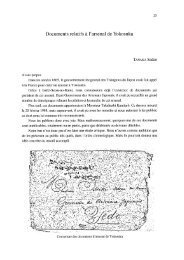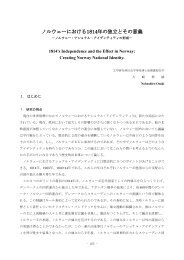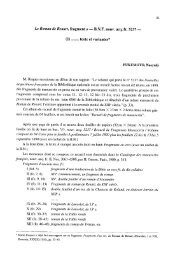Indian Writing in English 1794-2004 - Soka University Repository
Indian Writing in English 1794-2004 - Soka University Repository
Indian Writing in English 1794-2004 - Soka University Repository
You also want an ePaper? Increase the reach of your titles
YUMPU automatically turns print PDFs into web optimized ePapers that Google loves.
192<br />
Read him Ghalib's discourse just once to show how.<br />
(Jo yeh kaheye Rekhta kiunkar ho rashk-I-Farsi'<br />
Guftta Ghalib aik bar parh key usey soona ke `Youn'.)<br />
Assert<strong>in</strong>g Urdu's dist<strong>in</strong>ctiveness and, for some, superiority over Persian was simpler to do<br />
than to locate the language <strong>in</strong> the social sett<strong>in</strong>g of north-western India. Incorporat<strong>in</strong>g Urdu<br />
<strong>in</strong>to H<strong>in</strong>dustani without separat<strong>in</strong>g it from H<strong>in</strong>di identified it with Persian and Sanskrit alike"<br />
(p. 105).<br />
xi For more <strong>in</strong>formation about Gandhi's views on language see Gandhi's "Letter to Vasumati<br />
Pandit Dated November 12, 1924" <strong>in</strong> The Collected Works of Mahatma Gandhi, Vol. XXV,<br />
(Delhi: The Publications Division, M<strong>in</strong>istry of Information and Broadcast<strong>in</strong>g, Government of<br />
India, May 1967). In the letter Gandhi advises Pandit not to worry about mistakes as<br />
"Language is a medium for communication of thought . Everyth<strong>in</strong>g is all right so long as there<br />
is noth<strong>in</strong>g wrong <strong>in</strong> the thought. A demon sitt<strong>in</strong>g <strong>in</strong> an aeroplane is not worthy of our respect,<br />
but a sadhu sitt<strong>in</strong>g <strong>in</strong> a bullock cart is" (p. 309).<br />
xii Gandhi felt that the vernacular languages and H<strong>in</strong>dustani should be used with<strong>in</strong> the country as<br />
legal and adm<strong>in</strong>istrative languages while <strong>English</strong> as the language of diplomacy abroad. In his<br />
"Presidential Address at Belgaum Congress December 26 , 1924" <strong>in</strong> Collected Works of<br />
Mahatma Gandhi, Vol. XXV, ibid., Gandhi said, "The official language for prov<strong>in</strong>cial gov-<br />
ernments, legislatures and courts, with<strong>in</strong> a def<strong>in</strong>ite period, to be the vernacular of the<br />
prov<strong>in</strong>ce; of the Privy Council, the f<strong>in</strong>al court of appeal, to be H<strong>in</strong>dustani; the script to be<br />
either Devanagri or Persian. The language of the Central Government and of the Central<br />
Legislature to be H<strong>in</strong>dustani, The language of <strong>in</strong>ternational diplomacy to be <strong>English</strong>" (p.<br />
481).<br />
xiii We can see the <strong>in</strong>fluence of the <strong>English</strong> Romantics such as Shelley and Keats on the writ<strong>in</strong>gs<br />
of Jai Shaker Prasad or Sumitranandan Pant. Premchand's realism was undoubtedly rem<strong>in</strong>is-<br />
cent of Charles Dickens and Bankim Chandra's Durgesh Nand<strong>in</strong>i closely resembled, if not a<br />
plagiarized version of, Walter Scott's Ivanhoe.<br />
xiv It is possible to argue that many <strong>Indian</strong>-<strong>English</strong> novelists use themes, characters and at times<br />
even locales that are essentially <strong>Indian</strong> but their choice of the <strong>English</strong> medium does not trans-<br />
form them <strong>in</strong>to non-<strong>Indian</strong> writers. Mulk Raj Anand's Private Life of an <strong>Indian</strong> Pr<strong>in</strong>ce,<br />
Manohar Mulgonker's The Pr<strong>in</strong>cess, even Raja Rao's The Serpent and the Rope (though<br />
located <strong>in</strong> England and France nevertheless has characters like Rama and Savithri are <strong>Indian</strong>)<br />
or R. K. Narayan's Malgudi novels (South <strong>Indian</strong> life) are qu<strong>in</strong>tessentially <strong>Indian</strong> <strong>in</strong> theme<br />
and sensibility though written <strong>in</strong> <strong>English</strong>.<br />
xv Sr<strong>in</strong>ivasa Iyengar, <strong>Indian</strong> <strong>Writ<strong>in</strong>g</strong> <strong>in</strong> <strong>English</strong>, (Bombay: Asia Publish<strong>in</strong>g House, 1973), p. 5.<br />
xvi Obviously we must exclude the works of Rudyard Kipl<strong>in</strong>g (Barrack-Room Ballads, Pla<strong>in</strong><br />
Tales from the Hills, The City of Dreadful Nights), E. M. Forster (A Passage to India), Pearl S<br />
Buck (Come My Beloved) or Louise Broomfield (The Ra<strong>in</strong>s Came) from the canon of <strong>Indian</strong><br />
writ<strong>in</strong>g <strong>in</strong> <strong>English</strong> as they belong to the category of either <strong>English</strong> or American literature<br />
though their themes might be <strong>Indian</strong>.<br />
xvii R. C. Churchill and George Sampson, The Concise Cambridge History of <strong>English</strong> Literature,<br />
(ELBS, 1972), p. 742.<br />
xviii This seems to be the op<strong>in</strong>ion of many literary scholars and writers like Aijaz Ahmad (In


